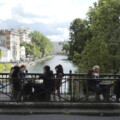The United States of America is the world’s largest wine producer outside of Europe, fourth behind only Italy, Spain, and France. More than 80 percent of that production comes from California, as do 95 percent of U.S. wine exports. By far the largest export market for American wine by revenue is Canada, which bought USD $484 million worth in 2022, more than number two U.K. ($192M) and number three Japan ($125M) put together. Isn’t it nice to know we’re valued somewhere?
Canada is valued enough to have its own office of the California Wine Institute which, among other things, promotes trade and consumer shows like the one that toured Calgary, Toronto, and Montreal this month. I attended the Toronto show this week, which California Wines Canada Director Danielle Giroux explained was the 32nd held in the city and named Eureka! after the state wine industry’s continuing commitment to innovation.
With over 500 wines poured, there was a lot to taste and not enough time to do it all. A strategic mix of the familiar and new had to be adopted, and to the extent that the strategy worked, here are four wines out of a great multitude that made an impression.

Harvey & Harriet White Blend 2021, San Luis Obispo County
Harvey & Harriet is the “entry-level” label wine made by Eric Jensen, whose Booker vineyard is in Paso Robles, and whose serious wines, made under the Favorite Neighbour and Booker labels, have what wine writers call a “cult following,” which in practice means they command very large price tags. The Harvey & Harriet line, which is priced around $30, is named after the winemaker’s parents and seems to be designed for fun. The white is certainly a blend, with grapes whose origins come from all over Europe but get along just fine in their Central California melting pot: Chardonnay, Albariño, Viognier, and Pinot Grigio.
There’s weight and a generosity to this wine with soft aromatics over big tropical fruit. The Harvey & Harriet is a 21st-century California wine with more in common with Provence than Burgundy. It was introduced to me at lunch, where it held up very well to a salad of mixed greens with pistachios; had the main been white wine-friendly, it would have very happily continued through the meal.
McManis Chardonnay 2021, River Junction
California makes some of the world’s most expensive wines. Several years ago a vintner who makes one of them explained that, due to real estate prices alone, the break-even point on a bottle of wine from the Napa Valley was USD $65. It can only have gone up, which is why it was good to see a wine that has held value, despite these inflationary times.
The McManis wines, like their classic California Chardonnay, come from the not-so-sexy Central Valley, but the family-run wine business has kept an eye on quality since they started bottling their own wines in the 1990s. Their Chardonnay is a bit like going back to the 90s, actually, with lots of round fruit (peaches and lemons) and a distinctive, if old-fashioned, buttery note. It’s a much more luxurious wine than its CAD $22 (in Ontario) price tag. I was pleased to be reacquainted with it, as well as their equally solid black-fruited Cabernet Sauvignon. This Chardonnay wants seafood, or maybe a BLT for lunch on Saturday.
Foxen Pinot Noir 2020, Santa Maria Valley
I try to avoid bigotry, but I am innately suspicious of Pinot Noir that’s not from a “cool climate,” like Burgundy, Oregon, or Ontario. I need to get over myself. The whole idea of a cool climate in the age of global warming might itself be obsolete. In any event, as anyone who’s seen the movie Sideways knows, the Central Coast of California makes some of the world’s prettiest Pinot’s and, after tasting through a bunch of powerful Cabernet Sauvignons and Zinfandels, it woke my palate right up.
Foxen is one of the region’s more established wineries, and their Pinot is full of bright red fruit, oscillating between cherry and cranberry, with a touch of earthiness and sandy tannins holding everything together. It’s the kind of wine that commands attention and contemplation. At around $40 it’s not cheap, but these days that’s the floor for well-made Pinot.
Ridge Geyserville 2021, Alexander Valley (Sonoma)
I remember buying my first bottle of Ridge red wine sometime in the late 1990s because I broke my self-imposed $20 price barrier. It was recommended by a slightly older American friend and I had high expectations, which were ultimately met, though the thrill of tasting the complex and intriguing was tempered with the knowledge my encounters with it would be infrequent. This has turned out to be the case since these legendary wines with their distinctive wordmark labels are priced to be reserved for special occasions.
Once I’d negotiated the line of sommeliers at the Ridge table, I tasted through three of their Sonoma County reds, including the Geyserville 2021. I particularly like this wine in part because it has a good story. (Context matters greatly when tasting wine; blind tasters try and eliminate it, but I mostly try to embrace it.) Ridge has been making wine from this vineyard since the 1960s. It was planted in the 1880s and holds some very old vines. It’s a “field blend”, which means the different kinds of grapes that make it are grown side by side and all mixed up when they’re picked so that they are fermented and elevated together.
It’s dominated by Zinfandel (69 percent) but has a high proportion of Carignan (20 percent), rounded out by Petit Sirah (8 percent), and two wildcards: Alicante Bouschet (2 percent) and Mataro (1 percent). It’s the old vine Carignan that I think gives it a particularly deep dark fruit character. Or maybe it’s the old vine Zinfandel that shows more to plums. Or maybe it’s everything grown together and put together in a magic way and the sum is greater than its parts. It’s a wonderfully complex wine that marries power with elegance, a bit like the state it comes from.
Recommended for You

Matthew Grills: Joey Chestnut is America

Malcolm Jolley: The comfort of familiar favourites—or the fun of finding new wines?

Malcolm Jolley: An ‘Elbows Up’ wine project everyone can get behind

Malcolm Jolley: Need some summer wines? Look no further than the food-friendly, low-sugar sippers of the sunny Southern Rhône




